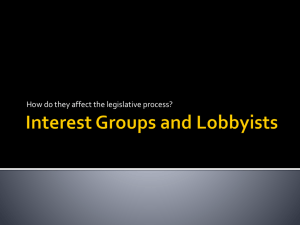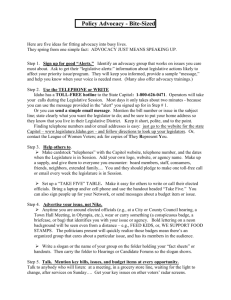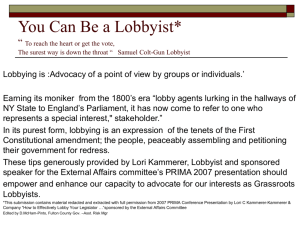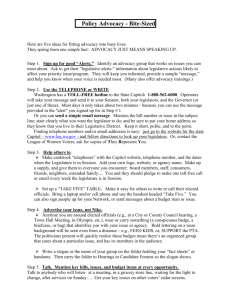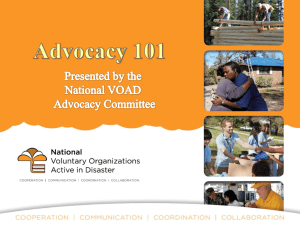Public Health Advocacy
advertisement
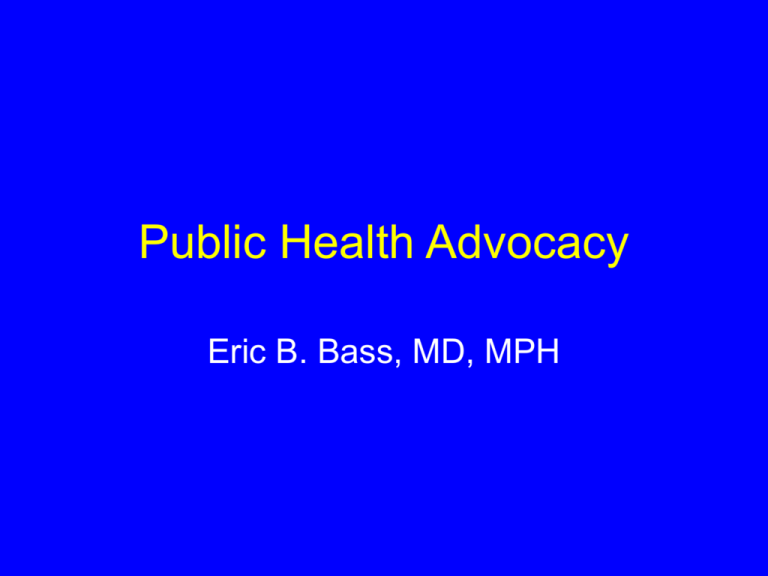
Public Health Advocacy Eric B. Bass, MD, MPH What can you do to impact the field of medicine or improve the healthcare system? • “I believe that working with local advocacy groups to change the system can have an effect, even if it may be small.” • “I hope to make an impact…particularly for children in urban areas, by increasing awareness & advocating for reform.” • “I see myself getting politically active in advocating for the ridiculous prices of prescription drugs to be more regulated…” • “Be an advocate for patients who normally fall thru the cracks in the healthcare system.” • “…lobbying for stronger legal representation of physicians in the U.S. government. One must take an active role in the government...” • “I may be interested in taking some type of political role in medicine, fighting for the interests of patients, which naturally entails fighting for the interests of doctors.” Health Care Lobbying in U.S. Am J Med 2004; 116: 474 • How much was spent on health care lobbying in 2000? • What % was spent by pharmaceutical & health product companies? • What % was spent by physicians & other health professionals? • What % was spent by disease advocacy & public health organizations? • Who spent more, AMA or PHRMA? Why is health a political issue? Annu Rev Public Health 2006; 27: 195 • Individual & institutional health actions have spillover effects • Citizens expect government to satisfy physical, economic & psychological needs • Protecting public health involves moral judgments that acquire legitimacy thru political debate • Healthy population is vital to economic growth & social order When do health problems become political issues? • Documentation of scientifically & socially credible threat • Agreement on who or what is responsible for the problem • Social views about affected populations • Annu Rev Public Health 2006; 27: 195 Why are health policy changes usually incremental? • Limited time & information to think about problems & solutions • Checks & balances in political system act to disperse power & prevent tyranny of popular majorities • Political resources distributed among interest groups • Fiscal constraints • Annu Rev Public Health 2006; 27: 195 When are major policy changes possible? JW Kingdon 1984 • Abrupt shift in how a problem is perceived or in who controls government • Convergence of 3 streams in policy process – Problem stream – Policy stream – Political stream • Presence of policy entrepreneurs & supportive government insiders How can YOU influence policy? “90% of life is just showing up.” Woody Allen Diagnose political nature of an issue J Child Neurol 2001; 16: 513 • Measure public priorities/opinions: – nationaljournal.com, pollingreport.com – www.healthaffairs.org • Measure media coverage: – Lexis-Nexis, Dialog, Westlaw databases – www.nytimes.com/pages/health/policy/index.html – www.washingtonpost.com • Find priorities of legislative majority: – www.gop.com, www.democrats.org • Categorize the salience of issue: – High (e.g., prescription drugs for Medicare) – Medium (e.g., graduate medical education) – Low Identify key political decision makers J Child Neurol 2001; 16: 513 • Which governmental organization? – Federal vs. State – Legislative vs. Executive vs. Judicial – Non-governmental • Who in organization? – Organizational Web sites – AMA Congressional Directory – www.vote-smart.org, www.apha.org/legislative/ • When & how? – Congressional Quarterly guides – Washington Post Weekly – Almanac of American Politics How does a bill become law? • • • • • • • • • • Conceptualization Introduction Committee hearings Committee bill Mark-up by committee Floor debate Floor vote Conference committee to reconcile differences Final vote in each house Signing by President/Governor Develop an appropriate strategy J Child Neurol 2001; 16: 513 • High salience – – – – – Think big Engage media Use experienced lobbyists Mobilize grass-roots organizations Create coalitions • Medium salience – Consider incremental changes – Focus on selected governmental leaders – Rely on knowledgeable experts • Low salience – Think long-term – Raise awareness thru media or research Identify groups that support your position • Professional societies – e.g., AMA, Med Chi, specialty organizations • Universities, hospitals & related organizations – e.g., AAMC, AHA • • • • Health insurance & managed care companies Disease advocacy organizations (e.g., ACS) Public health organizations (e.g., APHA) Foundations – e.g., Kaiser Family Foundation, Commonwealth Fund • Consumer organizations – e.g., Public Citizen, FamiliesUSA How else can you influence policy? • Develop relationship with & be a resource for a politician & his/her staff • Personal staff: – Chief of Staff or Legislative Director – Scheduler – Legislative Assistant or Legislative Correspondent • Committee staff: – Committee Chairperson & Ranking Minority member Examples of Successful Advocacy • Medicare Prescription Drug Improvement & Modernization Act of 2003 • Resurrection of Agency for Health Care Policy & Research, 1995 • NIH Student Loan Repayment Program • Health care liability reform in Texas, 2003 • Malpractice insurance rate relief in Maryland, 2004 • Maryland insurance chief bars conversion of CareFirst to for-profit status, 2003 • Massachusetts constitutional amendment calling for universal health care, 4/06 PAS Advocacy Assignment • Select topic of interest to you • Give oral presentation simulating a visit with a politician • Prepare 1-page letter Oral Presentation • Background prep – Identify issue – Set agenda – Describe politician’s expected position • Content of meeting – Define issue, citing facts – Give anecdote – Explain relevance to citizens – State position – Identify supporting groups – Plan follow-up True or False? • The majority of legislators have a staff member whose sole responsibility is health care issues. Personal Visit Etiquette • Make appointment 2 weeks in advance – Be flexible when scheduling – Be on time • • • • • • Prepare Identify yourself as a constituent Designate a spokesperson Thank legislator/staff for previous support Leave briefing sheet with contact information Send follow-up letter to designated staff person Personal Visit Don’ts • Don’t bother visiting if no chance of support • Don’t be disappointed if you meet with staff member • Don’t give nebulous recommendations • Don’t give expert opinion if unsure • Don’t use jargon or confusing statistics • Don’t deny self-interest • Don’t assume ignorance • Don’t be argumentative True or False? • Legislators will only reply to your letters if you live in their district. Letter Writing • • • • Time letter to maximize impact Identify pertinent bill Be sure return address is in legislator’s district Address to legislator or staff member – Spell name & title correctly • Personalize letter – Mention your experience & use anecdotes • Emphasize impact on constituency • Be concise Letter Writing Don’ts • • • • • • • Don’t send form letters Don’t write about too many issues Don’t forget to give supporting evidence Don’t send articles Don’t threaten Don’t make promises you can’t keep Don’t pretend to have more influence than you really have Summary • Healthcare lobbying is intense & physicians must have a voice • Be realistic about potential for major reform • Look for windows of opportunity • Use diagnostic skills & identify decision makers to design an appropriate strategy • Identify supporting groups & develop a relationship with a politician • Show up! Recommended Reading • Mebane F, Blendon RJ. Political Strategy 101: How to make health policy and influence political people. J Child Neurol 2001; 16: 513-8. • Oliver TR. The politics of public health policy. Annu Rev Public Health 2006; 27: 195-233. • Landers SH, Sehgal AR. Health care lobbying in the United States. Am J Med 2004; 116: 474-7. • Kingdon JW. Agendas, Alternatives, and Public Policies. Boston: Little, Brown; 1984. • Laugesen MJ, Rice T. Is the doctor in? The evolving role of organized medicine in health policy. J Health Politics Policy Law 2003; 28: 289-316.

